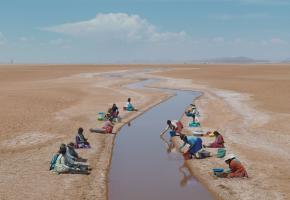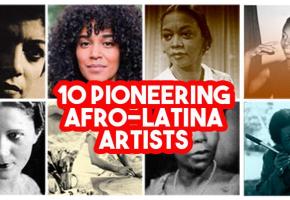Literally translated as ‘One More Tango’, this film tells the story of Argentina’s most famous dancing couple of Tango, Maria Nieves Rego and Juan Carlos Copes.
Having come from humble backgrounds, they met as teenagers when she was only 14 years old and he 17, and they ended up creating a dancing partnership that was to last 50 years. As choreographer, he developed what is now known as the ‘Copes method’ and together they took the Tango all over the world, introducing it to international audiences at a level not seen before. Wim Wenders (Pina, Buena Vista Social Club) was executive producer. Having excelled in the art of filming dance with ‘Pina’, (in 3D) it was an exceptionally propitious choice for Kral to have him on board.
Tango singers like Carlos Gardel had already popularized the music of Tango in the1920s and 30s, but it was Maria Nieves Rego and Juan Carlos Copes that danced their way into people’s hearts and minds in the 1940 and 50s, initially in Argentine theatres. Later, in the 1960s and on to the 80s, they took the Tango all over the world, on Broadway with the hit ‘Tango Argentino’, and even to Japan, where the Tango is very popular indeed. Their consummate elegance and timing still inspires awe.

Our last Tango is a poignant love story, driven by an overwhelming passion for the tango as an art form, so strong that they stayed together dancing for all those years despite tumultuous personal tensions. These experiences transformed their performances and their choreography so that in some ways, it expressed the relationship they were living through. Their love/hate on- off stage relationship was painful, fractured and yet, they managed to remain consummately professional. One particularly significant dance that Copes choreographed, was astonishingly danced entirely on a tiny table top. This seems to have represented them as a dancing couple, who despite being full of rage for each other, were also inextricably locked together by their overwhelming love of this special dance.
She admits today, that she never ceased to panic during that sequence, convinced she would fall off, her professionalism being such, that archival footage in the film, shows her managing to appear as cool and stunning as ever.
Kral deftly moves between using these archival scenes, dramatized sections and face- to- face interviews with the dancers, who are now in their early 80s. They talk about each other and their relationship with pain and love intermingled. He still describes her as his “Stradivarius” and she admits he was the love of her life and yet they have not talked to each other in years.

Kral’s stylized technique of combining various filmic elements, has been criticized by some who described it as being a “manipulative direction that feels artificial in the way the film is shot and edited, to provoke specific emotions in the viewer”. Surely this could be definition of what film is supposed to be?
Utilizing all these elements, Kral builds up a moving portrait of Nieves and Copes, revealing the lives they led as they danced their way around the world. There is no doubt that the ongoing conflict of their personal relationships added a dimension of enormous power to their performances. She admits they would argue, even as they danced, even insulting each other through gritted teeth: “Have you been eating rocks again? “He would quip.
Their lives were touched by infidelity, profound love as well as loss, summing up the very essence of Tango, both in the music, the lyrics and the dance forms. Yearning and loss being so much a part of the ‘porteños’ psyche, as much as for the city of Buenos Aires and its music. Perhaps this is inevitable in a port city that was largely populated by immigrants who still missed their homelands.
The dance sequences are riveting. As teenagers falling love, the dance is an erotically charged display, and as the film progresses, this changes through the choreography to also reflect a poignant sense of loss, and even nostalgia, dominated by that passion that transcended their own pain.
Another element that cannot be ignored in this dance is, quite simply, the amazing role played by ‘feet’. Even the wonderful shoes worn by the dancers, are in themselves a part of the experience, and I would imagine that anyone with a foot fetish would be in seventh heaven. Kral cleverly has scenes that focus on the legs and feet so that they become quite mesmerizing
The nostalgia, at times, has elements of a romantic soap opera. Juan Carlos Copes left Nieves for a woman 20 year his junior, having already had a child by her. This was devastating for Nieves who had dedicated her life to him and the dance. However, that was not the most painful experience for her. That was yet to come.
Copes is still active, now dancing with his own daughter (Johana Copes), and Nieves, looking sprite and light on her feet, still dreams she could dance for another 10 years. It all goes to show that age does not diminish passion: “I might be a veteran but when I am on stage, I am a lioness.”
Is this film strictly a documentary? Perhaps it is, if in rather a creative format, but it has a hypnotic quality and pulls you in emotionally. This magnetic couple paid for their ultimate fame in many ways. Nieves now lives alone, having left it too late to have children, yet she likes to insist that she is not bitter: “Love is a lie’, she declares, ‘You have to use men and throw them away’. “No tear shed by a woman for a man is worth it!”.
Director Germán Kral was born in Buenos Aires 1968 and studied Film at the Munich Film School. He collaborated with Wim Wenders on “A Trick of the Light”. He was nominated for the Grimme Prize in Germany and awarded the First Prize at the Yamagata Film Festival, later, he received the FFF Talent Award at the DOK.FEST (Munich) and the Starter Film Prize also in Munich.
OUR LAST TANGO will be released in UK cinemas on 22nd September 2017:
https://www.facebook.com/ourlasttangofilm
https://twitter.com/OurLastTango
https://www.instagram.com/ourlasttangofilm/
#OurLastTangoFilm
Argentina, Germany 2015
Language: Spanish with English subtitles
Cast & Crew:
Director: Germán Kral
Screenplay: Germán Kral and Daniel Speck
Production: Executive Producers Wim Wenders , Jakob Abrahamsson, and Rodrigo Fürth
Cinematography: Jo Heim and Félix Monti
Editing: Ulrike Tortora
Cast: Maria Nieves Rego, Juan Carlos Copes, Pablo Verón, Ayélen Álvarez Miño, J Juan Malizia, Pancho Martínez Pey, Alejandra Gutty, Johana Copes, Francesca Santapá
Music: Luis Borda, Gerd Baumann & Sexteto Mayor.

















